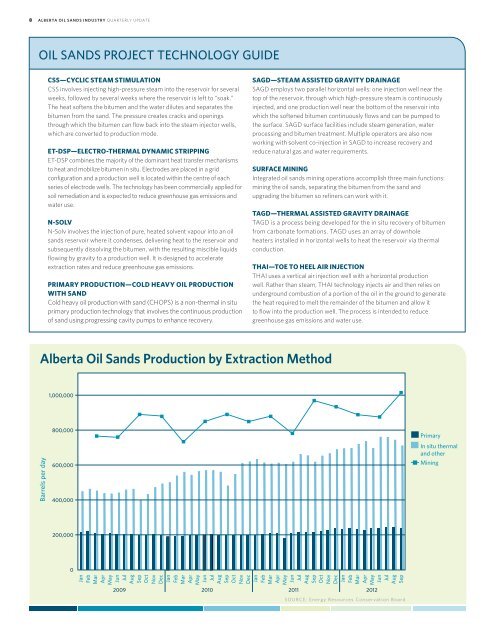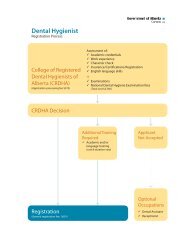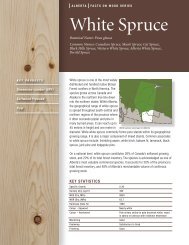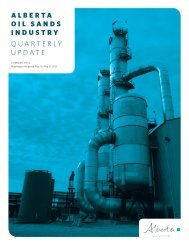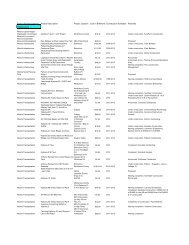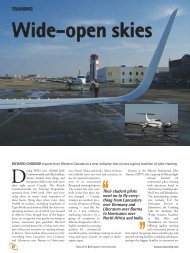Oil Sands Quarterly Winter 2013 - Alberta, Canada
Oil Sands Quarterly Winter 2013 - Alberta, Canada
Oil Sands Quarterly Winter 2013 - Alberta, Canada
Create successful ePaper yourself
Turn your PDF publications into a flip-book with our unique Google optimized e-Paper software.
8 ALBERTA OIL SANDS INDUSTRY QUARTERLY UPDATE<br />
OIL SANDS PROJECT TECHNOLOGY GUIDE<br />
CSS—CyCLIC STEAM STIMULATIoN<br />
CSS involves injecting high-pressure steam into the reservoir for several<br />
weeks, followed by several weeks where the reservoir is left to “soak.”<br />
The heat softens the bitumen and the water dilutes and separates the<br />
bitumen from the sand. The pressure creates cracks and openings<br />
through which the bitumen can flow back into the steam injector wells,<br />
which are converted to production mode.<br />
ET-DSP—ELECTRo-THERMAL DyNAMIC STRIPPING<br />
ET-DSP combines the majority of the dominant heat transfer mechanisms<br />
to heat and mobilize bitumen in situ. Electrodes are placed in a grid<br />
configuration and a production well is located within the centre of each<br />
series of electrode wells. The technology has been commercially applied for<br />
soil remediation and is expected to reduce greenhouse gas emissions and<br />
water use.<br />
N-SoLv<br />
N-Solv involves the injection of pure, heated solvent vapour into an oil<br />
sands reservoir where it condenses, delivering heat to the reservoir and<br />
subsequently dissolving the bitumen, with the resulting miscible liquids<br />
flowing by gravity to a production well. It is designed to accelerate<br />
extraction rates and reduce greenhouse gas emissions.<br />
PRIMARy PRoDUCTIoN—CoLD HEAvy oIL PRoDUCTIoN<br />
WITH SAND<br />
Cold heavy oil production with sand (CHOPS) is a non-thermal in situ<br />
primary production technology that involves the continuous production<br />
of sand using progressing cavity pumps to enhance recovery.<br />
<strong>Alberta</strong> <strong>Oil</strong> <strong>Sands</strong> Production by Extraction Method<br />
Barrels per day<br />
1,000,000<br />
800,000<br />
600,000<br />
400,000<br />
200,000<br />
0<br />
Jan<br />
Feb<br />
Mar<br />
Apr<br />
May<br />
Jun<br />
Jul<br />
Aug<br />
Sep<br />
Oct<br />
Nov<br />
Dec<br />
Jan<br />
Feb<br />
Mar<br />
Apr<br />
May<br />
2009<br />
Jun<br />
Jul<br />
Aug<br />
Sep<br />
Oct<br />
Nov<br />
Dec<br />
Jan<br />
Feb<br />
Mar<br />
Apr<br />
May<br />
2010<br />
SAGD—STEAM ASSISTED GRAvITy DRAINAGE<br />
SAGD employs two parallel horizontal wells: one injection well near the<br />
top of the reservoir, through which high-pressure steam is continuously<br />
injected, and one production well near the bottom of the reservoir into<br />
which the softened bitumen continuously flows and can be pumped to<br />
the surface. SAGD surface facilities include steam generation, water<br />
processing and bitumen treatment. Multiple operators are also now<br />
working with solvent co-injection in SAGD to increase recovery and<br />
reduce natural gas and water requirements.<br />
SURfACE MINING<br />
Integrated oil sands mining operations accomplish three main functions:<br />
mining the oil sands, separating the bitumen from the sand and<br />
upgrading the bitumen so refiners can work with it.<br />
TAGD—THERMAL ASSISTED GRAvITy DRAINAGE<br />
TAGD is a process being developed for the in situ recovery of bitumen<br />
from carbonate formations. TAGD uses an array of downhole<br />
heaters installed in horizontal wells to heat the reservoir via thermal<br />
conduction.<br />
THAI—ToE To HEEL AIR INjECTIoN<br />
THAI uses a vertical air injection well with a horizontal production<br />
well. Rather than steam, THAI technology injects air and then relies on<br />
underground combustion of a portion of the oil in the ground to generate<br />
the heat required to melt the remainder of the bitumen and allow it<br />
to flow into the production well. The process is intended to reduce<br />
greenhouse gas emissions and water use.<br />
Jun<br />
Jul<br />
Aug<br />
Sep<br />
Oct<br />
Nov<br />
Dec<br />
Jan<br />
Feb<br />
Mar<br />
Apr<br />
May<br />
Jun<br />
Jul<br />
Aug<br />
Sep<br />
2011 2012<br />
SOURCE: Energy Resources Conservation Board<br />
Primary<br />
In situ thermal<br />
and other<br />
Mining


